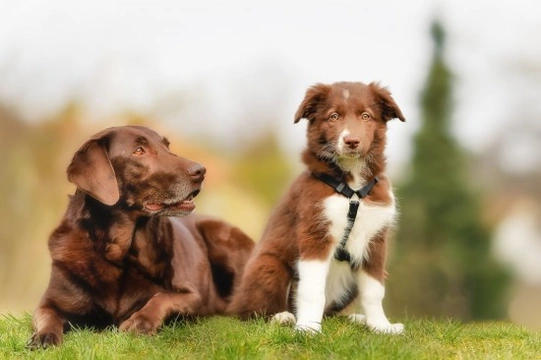Pets
Pets for studWanted petsBreedersAccessories & services
Knowledge hub
Support
Support & safety portal
Puppy aggression towards older dogs
Puppies of all ages up to around one year old are all transitioning through a very steep learning curve in terms of their lives and its parameters, while they navigate the world and learn their boundaries and what gleans a positive response and a negative one. This is of course a very formative time in the life of the young dog, and one that will essentially give the puppy the life skills it will use for the rest of its life.
As part of this learning process, puppies must learn about socialising and getting on with other, adult dogs, and the parameters of play and what it and is not ok. Play fighting and getting to grips with others is a large part of this, and adult dogs of all shapes and sizes will usually give much more leeway to puppy mistakes and overstepping their boundaries than they would do to older dogs.
However, how can you tell the difference between playing and actual aggression from your puppy to older dogs, and what can you do about it if your pup appears to respond aggressively to canine adults? Read on to learn more.
Play fighting and learning
As part of getting to grips with their lives as a dog, your puppy will use their teeth, bodies and paws as part of play fighting, which is when they learn skills such as bite inhibition, boundary control and when to stop and back off. Play fighting is an important stage of learning development, and you should not curb or interrupt your dog when they are going through this stage. However, it is possible for a play fight to potentially turn nasty or go too far, particularly given the fact that your pup will still be getting to grips with their bite inhibition and reading the signs given out by other dogs.
If your puppy nips or goes too far, the other dog will likely yelp, back off, or snarl back at your pup, all of which are communication tools that let your puppy know to back off. The only time that an issue then arises, is if your puppy does not listen to what they are being told by the adult dog.
How to tell play fighting from true aggression
Even though puppies are soft, young and cuddly, this does not mean that they are incapable of showing aggression! It is important to learn to identify true aggression from simple play fighting, in order to curb this behaviour in your pup while they are still young enough to be at their most receptive to learning.
Look out for snarling, biting the face and neck of the other dog, bared teeth and growling. Also, be alert for cues from the adult dog that are telling your pup to back off, and whether or not your pup heeds these cues and responds accordingly.
Fear resulting in aggression
As with everything in life, when your dog is frightened, they have to make the choice between fight and flight. Fear can ergo generate a strongly defensive response from your pup, which can manifest as aggression. This may be due to genuinely dominant or aggressive behaviour from the adult dog, or simply because your pup is intimidated by the other dog or fails to read the cues that indicate that the other dog is just playing.
In order to give your pup the best start to life and to prevent them becoming fearful and so aggressive to older dogs, it is important that the early stages of their lives are secure and carefully managed.
Introduce your pup to adult dogs on safe, neutral ground, and do not over-face your pup with too much stimulus at once. Ensure that they trust and rely on you and feel safe with you, and do not expose them simultaneously to totally new situations, places, dogs and people, as this can be a bit much! Ensure that your pup always has a line of retreat open to them when playing with others, and that they never have to be forced to choose aggression over retreating from a situation that they feel uncomfortable with.
Possessive and dominant puppy behaviour
When your pup is going to socialise or meet other dogs, it is a good idea to leave their toys at home, so that your pup will not feel as if they need to defend their toys or risk having them taken by the other dog.
If your young dog looks as if they are shaping up to have possessive tendencies, such as by resource guarding, snapping when approached eating, or hoarding their toys, nip this in the bud quickly, and do not give it further opportunities to manifest itself. If your dog is already wary and protective about their things, adding other dogs into the mix will only amplify this, and create the perfect environment for your pup to potentially show aggression.
Make sure that if there are treats going round that everyone gets their fair share and that your pup does not have to fight to keep his, and ensure that you give your own pup plenty of attention when petting other adult dogs too.
Health issues
If your pup appears to be rather fragile, easily hurt or fearful of getting hurt, get them checked out by your vet to ensure that there is not an underlying health issue at the root of the matter. Fear of pain or getting hurt by another dog can soon lead to defensive aggression, and once your pup has established a pattern of expecting other dogs to cause them harm, they are much more likely to react negatively to them in the future.



